 HL7 PA, R2-2010 HL7 Version 3 Standard: Patient Administration, DSTU Release 2 Update February 2010 Update to DSTU Release 2 |
Content Last Edited: 2011-06-17T13:44:56
6.2 Storyboards
6.3 Application Roles
6.4 Trigger Events
6.5 Refined Message Information Models
6.6 Hierarchical Message Descriptions
6.7 Interactions
A central event in the provision of health care is the patient encounter. Patient encounter is defined as an interaction between a patient and one or more healthcare participants for the purpose of providing patient services or assessing the health status of a patient. Examples of a patient encounter are an outpatient visit to multiple departments, home health support (including physical therapy), an inpatient hospital stay, an emergency room visit, a field visit (e.g., traffic accident), an office visit, occupational therapy, or a telephone call between a patient and a healthcare practitioner.
This document defines standards for information interchanges with ambulatory encounter information systems. Ambulatory encounter is a comprehensive term for health care provided in a facility or setting that provides diagnostic, therapeutic and health maintenance services for persons not requiring stays that exceed 24 hours (e.g. a practitioner's office, clinic setting, or hospital) on a nonresident and non-emergency basis. The term ambulatory implies that the patient has come to the location and is not assigned to a bed. An alternate term for ambulatory encounter is outpatient encounter. In HL7 version 2.x terms, an ambulatory encounter is a visit with a Patient Class (PV1-2) of "outpatient".
See the Short Stay Encounter topic for ambulatory encounters where the patient is assigned to a bed.
HL7v3 describes three interoperability paradigms - messages, documents and services. This document defines information interchanges in the message paradigm.
Information interchanges can be broadly categorized by the goal of the interchange - notification (no specific receiver responsibility), query (receiver expected to return information meeting query criteria) and action request (receiver expected to take requested action). This document defines notification interchanges. Query interactions are defined in the Encounter Queries topic. No action request interactions have yet been defined for this topic.
This document addresses notifications for the following:
- Ambulatory encounter appointment created
- Ambulatory encounter appointment rescheduled
- Ambulatory encounter appointment revised
- Ambulatory encounter appointment canceled
- Ambulatory encounter started
- Ambulatory encounter revised
- Ambulatory encounter completed
- Ambulatory encounter aborted
- Ambulatory encounter nullified (remove erroneous record)
The Patient Administration work group limited scope in this document by:
- Limiting storyboards to the simplest cases
- Excluding notification messages for state transitions "reactivate" and to/from "suspended" (see the Act State Diagram for Patient Administration Messages below; the unsupported states and transitions are grayed out in the diagram)
- Excluding action request interactions
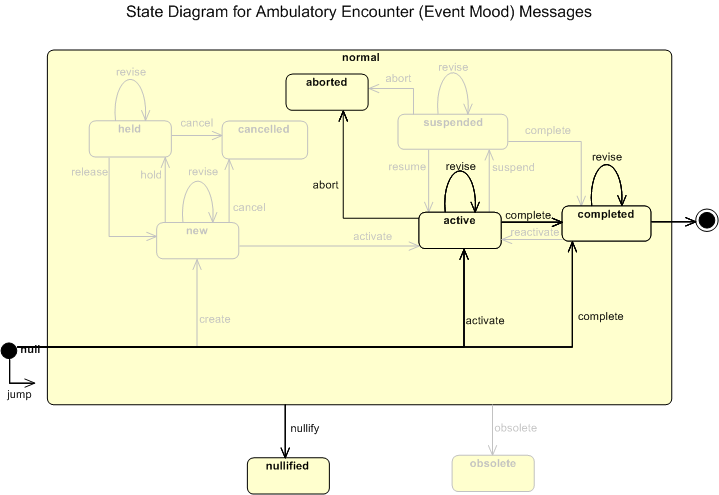
The Patient Administration Technical Committee invites implementers with additional requirements to submit content proposals for future releases of the standard.
This specification is defined for the universal realm. As a consequence, many attributes are bound to concept domains and many attributes and associations are left as optional. See the Refinement, Constraint and Localization section of HL7v3 for guidance on how to create a profile from this document.
The Patient Administration work group has not attempted to implement this content in either the document or services interoperability paradigms. The work group is interested in hearing from implementers who are considering exchanging this content in one of those paradigms.
This document was previously published as DSTU in 2007 and it is being issued as an updated DSTU again due to the lack of feedback from implementers. The Patient Administration work group wants to hear from implementers regarding the suitability for use of this content.
|
||||||||||||
|
For details on the interpretation of this section, see the storyboard discussion in the Version 3 Guide.
This storyboard demonstrates the basic flow of an ambulatory encounter from scheduled, through active, to completed.
Exceptional events are described in other storyboards.
- Canceling a scheduled ambulatory encounter is covered in Cancel Ambulatory Encounter Appointment.
- Abnormal termination of an active ambulatory encounter is covered in Abort Ambulatory Encounter.
- Nullifying an erroneously reported ambulatory encounter is covered in Nullify Ambulatory Encounter.
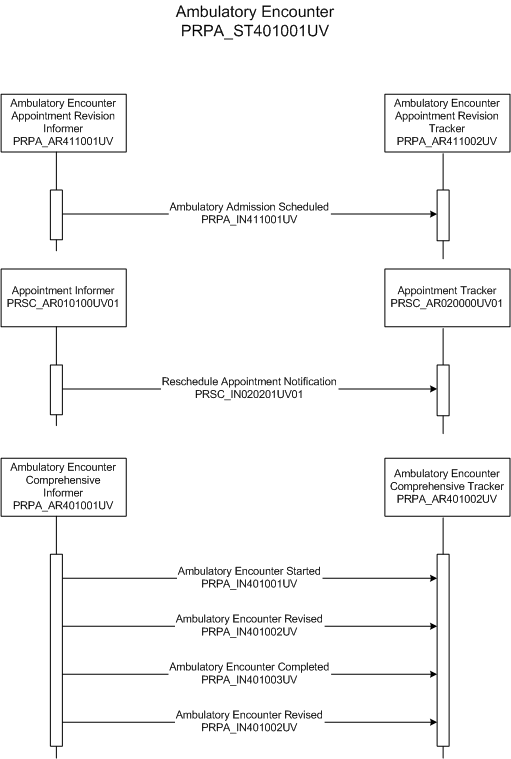
| Ambulatory Encounter Appointment Scheduled | |
| Ambulatory Encounter Started | |
| Ambulatory Encounter Revised | |
| Ambulatory Encounter Completed | |
| Ambulatory Encounter Revised |
Schedule Ambulatory Encounter
Mr. Adam Everyman is a 64-year-old male with severe chronic pain in his right hip. He called his primary care provider, Dr. Patricia Primary, for consultation. Dr. Primary's receptionist pulled Mr. Everyman's data up on the screen and created an appointment for the next afternoon at 3:00 PM [Interaction Ambulatory Encounter Appointment Scheduled].
Reschedule Ambulatory Encounter
Before his appointment, Dr. Patricia Primary's receptionist called to tell him that the appointment time needed to be changed. The new appointment was scheduled for 5:00 PM instead of 3:00 PM [Interaction Reschedule Appointment Notification].
Check In
Ten minutes before his scheduled appointment, Mr. Everyman arrived at Dr. Primary's office and checked in with the receptionist. After he reviewed his contact and insurance information he was shown to an examination room [Interaction Ambulatory Encounter Started].
Revise Active Ambulatory Encounter
Dr. Primary examined Mr. Everyman's inflamed hip. She saw that the encounter form incorrectly listed the reason for visit as "pain in left hip" instead of the right hip so she made a correction on the form. She gave Mr. Everyman a prescription for Naprosyn 500 mg. and told him that he did not need to schedule another visit.
Mr. Everyman returned to the front desk and gave the corrected encounter form to the receptionist who corrected the reason for visit [Interaction Ambulatory Encounter Revised].
Check Out
The receptionist completed the check out process for Mr. Everyman [Interaction Ambulatory Encounter Completed].
Post Check Out
During the office visit with Dr. Primary, Mr. Everyman mentioned that he did not want his family to worry about his condition. He asked Dr. Primary to be sure not to mention it when he and his wife came in for their next scheduled blood pressure check. When reviewing Mr. Everyman's record later that day, Dr. Primary noticed that the confidentiality request had not been recorded. Mr. Everyman's record was updated to note that the hip condition should not be mentioned to Mr. Everyman's family [Interaction Ambulatory Encounter Revised].
This storyboard demonstrates canceling an ambulatory encounter appointment.
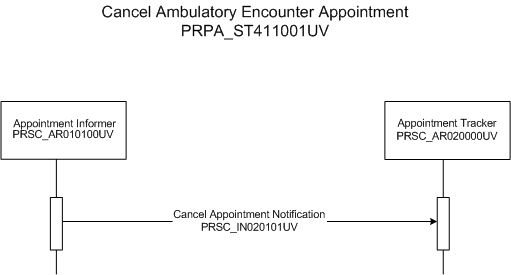
After reviewing the radiologist's report Dr. Primary decided that her patient, Eve Everywoman, did not require the follow-up appointment she had scheduled. She had her receptionist call Eve and cancel her upcoming appointment for an office visit [Interaction Cancel Appointment Notification].
This storyboard demonstrates abnormal termination of an ambulatory encounter.
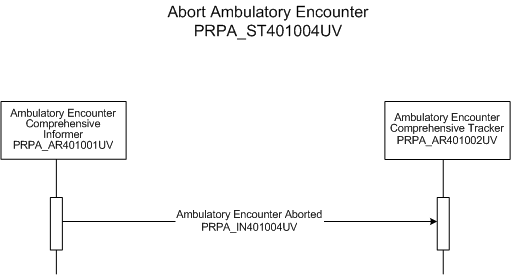
| Ambulatory Encounter Aborted |
Dr. Patricia Primary referred Mr. Adam Everyman to an orthopedic surgeon, Dr. Sara Specialize, for evaluation. Mr. Everyman checked in for his appointment with Dr. Specialize and was waiting in an examination room when Dr. Specialize was paged for an emergency at the hospital. Mr. Everyman agreed to return the next day instead of waiting for Dr. Specialize to return. The active ambulatory encounter was aborted [Interaction Ambulatory Encounter Aborted].
This storyboard demonstrates nullifying an erroneously reported ambulatory encounter.
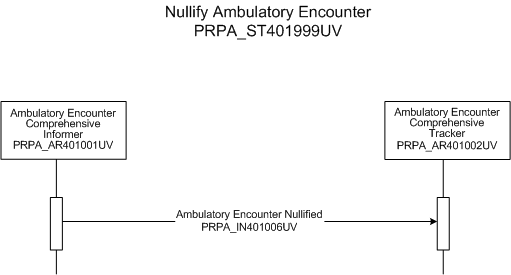
| Ambulatory Encounter Nullified |
Dr. Patricia Primary's receptionist noticed that there were two encounters recorded for Mr. Everyman's visit. She realized that she had entered the encounter information twice. One of the duplicate encounters was marked as "entered in error" and was nullified [Interaction Ambulatory Encounter Nullified].
|
||||||||||||
|
For details on the interpretation of this section, see the discussion of application roles and their relationships in the Version 3 Guide.
An Ambulatory Encounter Appointment Revision Informer sends appointment activate and revise notifications. Additional appointment notifications such as reschedule and cancel are sent by the Appointment Informer application role.
An Ambulatory Encounter Appointment Revision Tracker receives appointment activation and revision notification messages. Additonal appointment notifications such as rescheduled and canceled are received by the Appointment Tracker application role.
|
||||||||||||||||||
|
For details on the interpretation of this section, see the discussion of trigger events in the Version 3 Guide.
| Type: | State-transition based |
| State Transition: | AmbulatoryEncounterAppointment (PRPA_RM411001UV02) |
This trigger event signals that a new ambulatory encounter appointment was scheduled.
The Schedule Ambulatory Encounter trigger event is most closely aligned with the HL7 2.4 SIU^S12 - notification of new appointment booking event for an outpatient visit.
| Type: | State-transition based |
| State Transition: | AmbulatoryEncounterAppointment (PRPA_RM411001UV02) |
This trigger event signals that an ambulatory encounter appointment was modified before the appointment began.
The Revise Ambulatory Encounter Appointment trigger event is most closely aligned with the HL7 2.4 SIU^S14 - notification of appointment modification event for an outpatient visit.
| Type: | State-transition based |
| State Transition: | AmbulatoryEncounterEvent (PRPA_RM401001UV02) |
This trigger event signals that a new ambulatory encounter has started. This is variously called outpatient registration, ambulatory encounter check-in or admission for a short stay ambulatory encounter. If there was an appointment for this encounter then this trigger event also implicitly changes the status of the appointment to completed.
The Begin Ambulatory Encounter trigger event is aligned with two HL7 2.4 events, the ADT^A04 - register a patient event signaling the start of an outpatient encounter and the ADT^A01 - admit/visit notification where the patient class in the PV1-2 is outpatient signaling the start of a short stay (less than 24 hours) admission. Note that in v3 a separate trigger event is required to activate a new patient record.
| Type: | State-transition based |
| State Transition: | AmbulatoryEncounterEvent (PRPA_RM401002UV02) |
This trigger event signals that information about an ambulatory encounter has changed.
The Revise Ambulatory Encounter trigger event is most closely aligned with the HL7 2.4 ADT^A08 - update patient information event where the patient class in the PV1-2 is outpatient. However, in v3 this trigger event only signals a change to encounter information, changes to a patient's demographic information are signaled by a Revise Patient Information trigger event.
| Type: | State-transition based |
| State Transition: | AmbulatoryEncounterEvent (PRPA_RM401004UV02) |
This trigger event signals that an ambulatory encounter was aborted prior to completion. Either the practitioner or the patient ended the encounter prematurely.
The Abort Ambulatory Encounter trigger event is most closely aligned with the HL7 2.4 ADT^A03 - discharge/end visit event where the patient class in the PV1-2 is outpatient and the discharge disposition in the PV1-36 is "Left against medical advice or discontinued care."
| Type: | State-transition based |
| State Transition: | AmbulatoryEncounterEvent (PRPA_RM401003UV02) |
This trigger event signals that an ambulatory encounter ended normally. This is variously called end visit or ambulatory encounter check-out.
The End Ambulatory Encounter trigger event is most closely aligned with the HL7 2.4 ADT^A03 - discharge/end visit event where the patient class in the PV1-2 is outpatient.
| Type: | State-transition based |
| State Transition: | Act (COMT_RM001000UV) |
This trigger event signals that a previously-reported Ambulatory Encounter Started notification was sent in error and has been nullified.
The Nullify Ambulatory Encounter trigger event is most closely aligned with the HL7 2.4 ADT^A11 - cancel admit/visit notification event where the patient class in the PV1-2 is outpatient.
|
||||||||||||||
|
For details on the interpretation of this section, see the description of RMIMs in the Version 3 Guide.
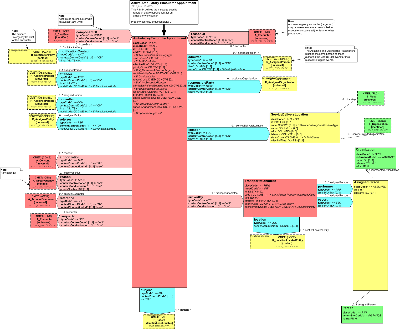
| Parent: | Patient Administration (PRPA_DM000000UV) |
The Active Ambulatory Encounter Appointment R-MIM defines the message used in notifications about active ambulatory encounter appointments. It is used by both "activate" and "revise" notifications. Descriptions for all classes, attributes and associations in this model can be found in the HMD and Message Type table views.
Encounter Attributes
The focal class (and entry point) is the EncounterAppointment class. The attributes of encounter appointment are:
-
id - the unique identifier for this encounter appointment
-
code = AMB, says that is an appointment for an ambulatory encounter
-
statusCode = "active"
-
effectiveTime - the anticipated start and (optional) end time for the scheduled encounter
-
priorityCode - the urgency for the scheduled encounter
-
confidentialityCode - a set of codes that control the disclosure of information about this scheduled patient encounter
-
reasonCode - a set of values specifying the administrative reasons for the encounter appointment. Examples are "Medical Necessity", "Patient's Request" and "Dependency". Medical reasons for the encounter are specified as associated diagnoses sent in A_ObservationDx CMET via the pertinentInformation act relationship described below.
-
admissionReferralSourceCode - a code used to categorize the type of place or organization responsible for the patient immediately prior to their scheduled encounter; for example, in the United States, this is identified in UB-92 Form Locator 20, Source of Adm(ission). Detailed information about the admitted-from place or type of place is conveyed through the arrivedBy act relationship to the TransportationAppointment (see below).
-
lengthOfStayQuantity - expresses the expected quantity of time for the scheduled encounter
-
preAdmitTestInd - indicates whether tests are required prior to this encounter. The encounter(s) for the pre-admit tests can be related to this scheduled encounter with the reason act relationship (see below).
-
specialCourtesiesCode - a set of values specifying special courtesies to be extended to the patient (e.g., no courtesies, extended courtesies, professional courtesy, VIP courtesies).
-
specialArrangementCode - a set of values representing the types of special arrangements to be provided for this patient encounter (e.g., wheelchair, stretcher, interpreter, attendant, seeing eye dog).
Links to Encounters
An encounter appointment can be the reason for another encounter (either event or appointment) for tests. The focal encounter appointment (target) is the reason for the pre-admission encounter (source).
Links to Other Acts
Encounter appointments can link to other acts:
-
TransportationIntent: the patient's expected arrival at the encounter site can be linked to the encounter via an arrivedBy: act relationship. The patient's mode of arrival is defined by a value from the ActPatientTransportationType domain sent in the TransportationIntent.code attribute, the admitted-from location in a R_LocationLocatedEntity CMET, and the time the patient is expected to arrive at the encounter site as the end of the TransportationAppointment.effectiveTime range.
-
A_AccountGuarantor: the scheduled encounter can be linked to one or more patient accounts. Each account is sent in a separate A_AccountGuarantor CMET.
-
A_ObservationDx: the scheduled encounter can be linked to one or more admission diagnoses . Each diagnosis is sent in a separate A_ObservationDx CMET. Multiple admission diagnoses can be rank ordered using the pertinentInformation.priorityNumber.
-
A_Consent: the scheduled encounter can be linked to one or more consents granted by the patient or the patient's representative. Each consent is sent in a separate A_Consent CMET. Note, this s currently a placeholder CMET until the Medical Records TC completes work on medico-legal document modeling.
Direct Participations in the Scheduled Encounter
A number of entities play roles that participate directly in the scheduled encounter:
-
admitter: the healthcare practitioner that required/authorized the scheduled encounter
-
responsibleParty: a healthcare provider organization that will hold clinical responsibility for the patient at the start of the scheduled encounter
-
location: the patient's assigned location at the start of the scheduled encounter
-
performer: practitioner(s) who will principally carry out the actions in the scheduled encounter
-
subject: the patient who is the subject of the scheduled encounter
-
referrer: the healthcare practitioner who requested the scheduled encounter to take place
-
consultant: an advisor who will participate in the scheduled encounter by performing evaluations and making recommendations
-
attender: the healthcare practitioner who will have responsibility for overseeing the patient's care at the start of the scheduled encounter
-
notificationContact: the patient's designated Emergency Contact for this scheduled encounter
| Active Ambulatory Encounter Appointment | PRPA_HD411001UV02 |
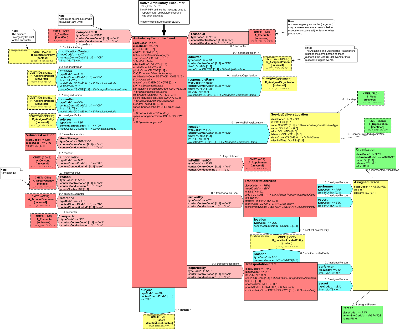
| Parent: | Patient Administration (PRPA_DM000000UV) |
The Active Ambulatory Encounter R-MIM defines the message used to report that a new ambulatory encounter has started.
AmbulatoryEncounterEvent
This information model is for ambulatory patient encounters in the active state. Ambulatory Encounter is a comprehensive term for health care provided in a facility or setting that provides diagnostic, therapeutic and health maintenance services for persons not requiring stays that exceed 24 hours (e.g. a practitioner's office, clinic setting, or hospital) on a nonresident and non-emergency basis. The term ambulatory implies that the patient has come to the location and is not assigned to a bed. Ambulatory encounters where a patient is assigned to a bed, such as ambulatory surgery and 24-hour observation encounters, should use the Short Stay encounter type.
The statusCode ("active"), and code ("AMB") should be considered fixed. Status changes are communicated using the provided trigger events and a change in encounter type requires completing the existing encounter and activating a new encounter of the appropriate type.
In an active encounter the following, if valued, should be interpreted as anticipated values: the end of the effectiveTime interval, the end of the activityTime interval, the lengthOfStayQuantity, and the dischargeDispositionCode.
Descriptions for all the attributes in this and the other classes in this model can be found in the HMD and Message Type table views.
Links to Other Encounters/Care Events
Encounters can relate to other encounters in three ways:
-
reasonOf: this can link the focal encounter (target) to one or more pre-admission patient encounters for tests (source). Note that the preAdmitTestInd for the focal encounter should also be set to "true".
-
sequelTo: this can link the focal encounter (source) to a previous encounter (target) for the same patient. Examples include: (1) a patient in an ambulatory encounter is admitted as an inpatient after an evaluation of the seriousness of the patient's condition, (2) an inpatient is discharged from an inpatient encounter directly to an ambulatory encounter as part of the same episode of care, (3) a patient is re-admitted to a healthcare facility.
-
componentOf: this can link the focal encounter (target) to a care event (source) of which it is a component. The care event represents someone (generally a health care practitioner) taking responsibility for some aspect of a patient's health; examples include primary/preferred care provider, case manager. Since Patient Encounter is a specialization of Care Encounter, the care event could also be another encounter.
Links to Other Acts
Encounters can link to other acts:
-
TransportationEvent (arrivedBy): describes the patient's arrival at the encounter site. The patient's mode of arrival can be sent as TransportationEvent.code, the admitted-from location in an origin type location participation of R_LocationLocatedEntity CMET, locations transited on the way to the encounter site as via type location participations, and the time patient arrived at the encounter site as the end of theTransportationEvent.effectiveTime interval. Both the performer (person who transported the patient) and an escort can be sent in R_AssignedPerson [contact] CMETs. The name of a transportation service can be sent as the name of the Organization scoping the AssignedPerson role.
-
TransportationIntent (departedBy): describes the patient's anticipated departure from the encounter site at the end of the encounter. The patient's mode of departure can be sent as TransportationIntent.code, the discharged-to location in an destinationtype location participation of R_LocationLocatedEntity CMET, locations expected to be transited as via type location participations, the time the patient is expected to depart from the encounter site as the start of theTransportationIntent.effectiveTime interval. Both the expected performer (person who will transport the patient) and an escort can be sent in R_AssignedPerson [contact] CMETs. The name of a transportation service can be sent as the name of the Organization scoping the AssignedPerson role.
-
A_Appointment (inFulfillmentOf): the focal encounter can be linked to the appointment that scheduled it. The scheduled encounter and the actual encounter should have the same value for type in Encounter.code. Activation of the encounter event implicitly changes the status code of the appointment to completed.
-
A_AccountGuarantor (reference): the encounter can be linked to one or more patient accounts. Each account is sent in a separate A_AccountGuarantor CMET.
-
A_ObservationDx (reason): the encounter can be linked to one or more diagnoses. Each diagnosis is sent in a separate A_ObservationDx CMET. The encounter "activate" interaction would send an admission diagnosis (Observation.code of "ADMX" in the A_ObservationDx CMET). Multiple admission diagnoses can be rank ordered using the reason.priorityNumber.
-
A_Consent (authorization): the encounter can be linked to one or more consents granted by the patient or patient's representative. Each consent is sent in a separate A_Consent CMET. Note, this is currently a placeholder CMET until the Medical Records TC completes work on medico-legal document modeling.
-
ValuablesLocation (sourceOf): the encounter can be linked to one or more reports of patient valuables stored during the encounter. Each report is sent as a free text observation of the valuables and where they are stored during the encounter.
Direct Participations in the Encounter
A number of entities play roles that participate directly in the encounter:
-
admitter: the healthcare practitioner that required/authorized the encounter, usually in the case of an inpatient encounter. Note: the admitter here must be the same as the author reported in the HL7 Trigger Event Control Act for the admission.
-
responsibleParty: the healthcare provider organization that holds clinical responsibility for care of the patient during the encounter. The encounter "activate" interaction activates the initial responsibleParty participation.
-
location: the patient's assigned location during the encounter. The encounter "activate" interaction activates the initial active location participation and, optionally, one or more pending location participations. ServiceDeliveryLocation is a role played by a place at which services may be provided. A service delivery location may be either an incidental service delivery location (a place at which services may be provided without prior designation or authorization) or a dedicated service delivery location (a place that is intended to house the provision of services). Dedicated service delivery locations can be further characterized as either clinical (DedicatedClinicalLocationRoleType) or non-clinical (DedicatedNonClinicalLocationRoleType).
-
subject: the patient who is the subject of the encounter.
-
referrer: the healthcare practitioner who requested the encounter to take place.
-
consultant: an advisor participating in the encounter by performing evaluations and making recommendations.
-
attender: the healthcare practitioner who has responsibility for overseeing a patient's care during the patient encounter. The encounter "activate" interaction activates the initial attender participation.
-
notificationContact: the patient's designated Emergency Contact for this encounter.
| Active Ambulatory Encounter | PRPA_HD401001UV02 |
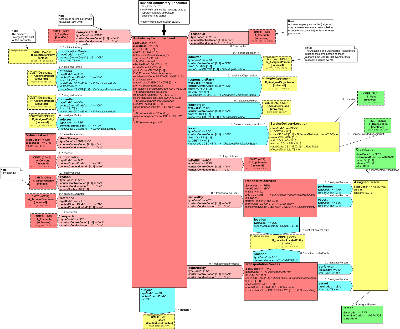
| Parent: | Patient Administration (PRPA_DM000000UV) |
The Revised Ambulatory Encounter R-MIM defines the message used to report that information about an ambulatory encounter has changed. The ambulatory encounter can be either active or completed.
Descriptions for all classes, attributes and associations in this model can be found in the HMD and Message Type table views.
Differences
The Revised Ambulatory Encounter R-MIM differs from the Active Ambulatory Encounter R-MIM in the following ways:
- The AmbulatoryEncounterEventstatusCode attribute can be any value from the ActStatusNormal value set.
- The departedBy Transportation act can be in either intent or event mood.
- The discharger participation is added to the model since the model applies to active and completed encounters.
| Revised Ambulatory Encounter | PRPA_HD401002UV02 |
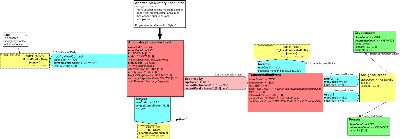
| Parent: | Patient Administration (PRPA_DM000000UV) |
The Aborted Ambulatory Encounter R-MIM defines the message used to report an ambulatory encounter was aborted prior to normal completion.
The Aborted Ambulatory Encounter R-MIM includes only the encounter attributes and associations that can be changed by aborting an encounter. The reason the encounter was aborted is conveyed in the Trigger Event Control Act portion of the HL7 composite message. The reasonCode attribute of the ControlActProcess conveys a simple, coded reason. More comprehensive information about why the encounter was aborted may be conveyed in a A_DetectedIssue CMET associated with the ControlActProcess via a reasonOf act relationship.
Descriptions for all classes, attributes and associations in this model can be found in the HMD and Message Type table views.
- The AmbulatoryEncounterEvent.statusCode is set to "aborted".
- The AmbulatoryEncounterEvent.effectiveTime contains actual values for both start and end date-times instead of an anticipated end date-time.
- The AmbulatoryEncounterEvent.activityTime is more likely to contain a value.
- The AmbulatoryEncounterEvent.lengthOfStayQuantity, if valued, contains the actual, calculated quantity (the actual days quantity cannot be simply calculated from the admission and discharge dates because of possible leaves of absence) instead of the expected length of stay.
- The AmbulatoryEncounterEvent.dischargeDispositionCode, if valued, contains the actual discharge disposition instead of the expected discharge disposition.
- The departedBy act relationship links AmbulatoryEncounterEvent to TransportationEvent.
- The patient's notificationContact is included to permit sending the emergency contact who was notified when the encounter was aborted.
| Aborted Ambulatory Encounter | PRPA_HD401004UV02 |
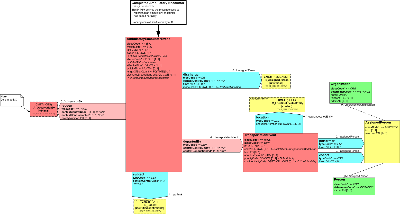
| Parent: | Patient Administration (PRPA_DM000000UV) |
The Completed Ambulatory Encounter R-MIM defines the message used to report that an ambulatory encounter has ended normally.
Descriptions for all classes, attributes and associations in this model can be found in the HMD and Message Type table views.
The Completed Ambulatory Encounter R-MIM includes only the encounter attributes and associations that can be changed by encounter completion:
- The AmbulatoryEncounterEvent.statusCode is set to "completed".
- The AmbulatoryEncounterEvent.effectiveTime contains actual values for both start and end date-times instead of an anticipated end date-time.
- The AmbulatoryEncounterEvent.activityTime is more likely to contain a value.
- The AmbulatoryEncounterEvent.lengthOfStayQuantity, if valued, contains the actual, calculated quantity (the actual days quantity cannot be simply calculated from the admission and discharge dates because of possible leaves of absence) instead of the expected length of stay.
- The AmbulatoryEncounterEvent.dischargeDispositionCode, if valued, contains the actual discharge disposition instead of the expected discharge disposition.
- The departedBy act relationship links AmbulatoryEncounterEvent to TransportationEvent.
- There is a discharger participation in AmbulatoryEncounterEvent. The discharger is the healthcare practitioner that required/authorized the ending of an encounter.
- The reason act relationship can convey one or more discharge diagnoses. Each diagnosis is sent in a separate A_ObservationDx CMET. The reason.priorityNumber specifies rank order if more than one discharge diagnosis is sent. Note that reason refers to the reason for the encounter itself, not the reason for the discharge; that reason would be conveyed in the Trigger Event Control Act.
| Completed Ambulatory Encounter | PRPA_HD401003UV02 |
|
||||||||||||||
|
For details on the interpretation of this section, see the description of HMDs in the Version 3 Guide.
This HMD defines notification messages about active ambulatory encounter appointments.
| A_EncounterUniversal | COCT_MT010000UV01 |
| A_EncounterUniversal | COCT_MT010000UV01 |
| R_NotificationPartyContact | COCT_MT040203UV09 |
| R_PatientIdentified/confirmable | COCT_MT050002UV07 |
| R_LocationLocatedEntityContact | COCT_MT070003UV02 |
| R_AssignedEntityUniversal | COCT_MT090000UV01 |
| R_AssignedPersonUniversal | COCT_MT090100UV01 |
| R_AssignedPersonUniversal | COCT_MT090100UV01 |
| R_AssignedPersonUniversal | COCT_MT090100UV01 |
| R_AssignedOrganizationUniversal | COCT_MT090200UV01 |
| A_AccountGuarantorUniversal | COCT_MT110300UV04 |
| A_ObservationDxMinimal | COCT_MT120104UV |
| E_OrganizationIdentified | COCT_MT150001UV01 |
| A_ConsentUniversal | COCT_MT470000UV |
| A_CareEventIdentified | COCT_MT520001UV |
| E_PlaceUniversal | COCT_MT710000UV07 |
| Active Ambulatory Encounter Appointment | PRPA_MT411001UV02 |
This HMD defines the message used to report that a new ambulatory encounter has started.
| A_EncounterUniversal | COCT_MT010000UV01 |
| A_EncounterUniversal | COCT_MT010000UV01 |
| A_AppointmentUniversal | COCT_MT020000UV01 |
| R_NotificationPartyContact | COCT_MT040203UV09 |
| R_PatientIdentified/confirmable | COCT_MT050002UV07 |
| R_LocationLocatedEntityContact | COCT_MT070003UV02 |
| R_AssignedEntityUniversal | COCT_MT090000UV01 |
| R_AssignedPersonUniversal | COCT_MT090100UV01 |
| R_AssignedPersonUniversal | COCT_MT090100UV01 |
| R_AssignedPersonUniversal | COCT_MT090100UV01 |
| R_AssignedOrganizationUniversal | COCT_MT090200UV01 |
| A_AccountGuarantorUniversal | COCT_MT110300UV04 |
| A_ObservationDxMinimal | COCT_MT120104UV |
| E_OrganizationIdentified | COCT_MT150001UV01 |
| A_ConsentUniversal | COCT_MT470000UV |
| A_CareEventIdentified | COCT_MT520001UV |
| E_PlaceUniversal | COCT_MT710000UV07 |
| Active Ambulatory Encounter | PRPA_MT401001UV02 |
This HMD defines the message used to report that information about an ambulatory encounter has changed.
| A_EncounterUniversal | COCT_MT010000UV01 |
| A_EncounterUniversal | COCT_MT010000UV01 |
| A_AppointmentUniversal | COCT_MT020000UV01 |
| R_NotificationPartyContact | COCT_MT040203UV09 |
| R_PatientIdentified/confirmable | COCT_MT050002UV07 |
| R_LocationLocatedEntityContact | COCT_MT070003UV02 |
| R_AssignedEntityUniversal | COCT_MT090000UV01 |
| R_AssignedPersonUniversal | COCT_MT090100UV01 |
| R_AssignedPersonUniversal | COCT_MT090100UV01 |
| R_AssignedPersonUniversal | COCT_MT090100UV01 |
| R_AssignedPersonUniversal | COCT_MT090100UV01 |
| R_AssignedOrganizationUniversal | COCT_MT090200UV01 |
| A_AccountGuarantorUniversal | COCT_MT110300UV04 |
| A_ObservationDxMinimal | COCT_MT120104UV |
| E_OrganizationIdentified | COCT_MT150001UV01 |
| A_ConsentUniversal | COCT_MT470000UV |
| A_CareEventIdentified | COCT_MT520001UV |
| E_PlaceUniversal | COCT_MT710000UV07 |
| Revised Ambulatory Encounter | PRPA_MT401002UV02 |
This HMD defines the message used to report that an ambulatory encounter was aborted prior to normal completion. It includes only enough information to identify the aborted encounter and the reason it was aborted.
| R_NotificationPartyContact | COCT_MT040203UV09 |
| R_PatientIdentified/confirmable | COCT_MT050002UV07 |
| R_LocationLocatedEntityContact | COCT_MT070003UV02 |
| Aborted Ambulatory Encounter | PRPA_MT401004UV02 |
This HMD defines the message used to report that an ambulatory encounter has ended normally.
| R_PatientIdentified/confirmable | COCT_MT050002UV07 |
| R_LocationLocatedEntityContact | COCT_MT070003UV02 |
| R_AssignedPersonUniversal | COCT_MT090100UV01 |
| A_ObservationDxMinimal | COCT_MT120104UV |
| Completed Ambulatory Encounter | PRPA_MT401003UV02 |
|
||||||||||||||||||
|
For details on the interpretation of this section, see the definition of Interactions in the Version 3 Guide.
This interaction occurs after an ambulatory encounter appointment is scheduled. An informer sends to a tracker a complete ambulatory appointment record, including related acts and participations.
| Trigger Event | Ambulatory Encounter Appointment Scheduled | PRPA_TE411001UV02 |
| Transmission Wrapper | Send Message Payload | MCCI_MT000100UV01 |
| Control Act Wrapper | Trigger Event Control Act | MCAI_MT700201UV01 |
| Message Type | Active Ambulatory Encounter Appointment | PRPA_MT411001UV02 |
| Sender | Ambulatory Encounter Appointment Revision Informer | PRPA_AR411001UV02 |
| Receiver | Ambulatory Encounter Appointment Revision Tracker | PRPA_AR411002UV02 |
This interaction occurs after an ambulatory encounter appointment is revised before the encounter has started. An informer sends to a tracker a complete ambulatory appointment record, including related acts and participations.
| Trigger Event | Ambulatory Encounter Appointment Revised | PRPA_TE411002UV02 |
| Transmission Wrapper | Send Message Payload | MCCI_MT000100UV01 |
| Control Act Wrapper | Trigger Event Control Act | MCAI_MT700201UV01 |
| Message Type | Active Ambulatory Encounter Appointment | PRPA_MT411001UV02 |
| Sender | Ambulatory Encounter Appointment Revision Informer | PRPA_AR411001UV02 |
| Receiver | Ambulatory Encounter Appointment Revision Tracker | PRPA_AR411002UV02 |
This interaction occurs after a new ambulatory encounter starts. An informer sends to a tracker a complete ambulatory encounter record, including related acts and participations.
| Trigger Event | Ambulatory Encounter Started | PRPA_TE401001UV02 |
| Transmission Wrapper | Send Message Payload | MCCI_MT000100UV01 |
| Control Act Wrapper | Trigger Event Control Act | MCAI_MT700201UV01 |
| Message Type | Active Ambulatory Encounter | PRPA_MT401001UV02 |
| Sender | Ambulatory Encounter Comprehensive Informer | PRPA_AR401001UV02 |
| Receiver | Ambulatory Encounter Comprehensive Tracker | PRPA_AR401002UV02 |
This interaction occurs after information about an ambulatory encounter changes (except for changes to Attending Practitioner, Patient Location and Responsible Organization participations that cause separate interactions). An informer sends to a tracker a complete ambulatory encounter record, including related acts and participations.
| Trigger Event | Ambulatory Encounter Revised | PRPA_TE401002UV02 |
| Transmission Wrapper | Send Message Payload | MCCI_MT000100UV01 |
| Control Act Wrapper | Trigger Event Control Act | MCAI_MT700201UV01 |
| Message Type | Revised Ambulatory Encounter | PRPA_MT401002UV02 |
| Sender | Ambulatory Encounter Comprehensive Informer | PRPA_AR401001UV02 |
| Receiver | Ambulatory Encounter Comprehensive Tracker | PRPA_AR401002UV02 |
This interaction occurs after an ambulatory encounter is aborted prior to completion. This could have been result of action by either the practitioner or the patient. An informer sends to a tracker information about the end of the encounter and the reason the encounter was aborted.
| Trigger Event | Ambulatory Encounter Aborted | PRPA_TE401004UV02 |
| Transmission Wrapper | Send Message Payload | MCCI_MT000100UV01 |
| Control Act Wrapper | Trigger Event Control Act | MCAI_MT700201UV01 |
| Message Type | Aborted Ambulatory Encounter | PRPA_MT401004UV02 |
| Sender | Ambulatory Encounter Comprehensive Informer | PRPA_AR401001UV02 |
| Receiver | Ambulatory Encounter Comprehensive Tracker | PRPA_AR401002UV02 |
This interaction occurs after an ambulatory encounter ends. An informer sends to a tracker a complete ambulatory encounter record, including related acts and participations.
| Trigger Event | Ambulatory Encounter Completed | PRPA_TE401003UV02 |
| Transmission Wrapper | Send Message Payload | MCCI_MT000100UV01 |
| Control Act Wrapper | Trigger Event Control Act | MCAI_MT700201UV01 |
| Message Type | Completed Ambulatory Encounter | PRPA_MT401003UV02 |
| Sender | Ambulatory Encounter Comprehensive Informer | PRPA_AR401001UV02 |
| Receiver | Ambulatory Encounter Comprehensive Tracker | PRPA_AR401002UV02 |
This notification occurs after a previously reported Ambulatory Encounter Started notification interaction is nullified. Note that the payload is the Act Generic Status - Event message type from the Shared Messages domain.
| Trigger Event | Ambulatory Encounter Nullified | PRPA_TE401999UV02 |
| Transmission Wrapper | Send Message Payload | MCCI_MT000100UV01 |
| Control Act Wrapper | Trigger Event Control Act | MCAI_MT700201UV01 |
| Message Type | Act Generic Status - Event | COMT_MT001103UV01 |
| Sender | Ambulatory Encounter Comprehensive Informer | PRPA_AR401001UV02 |
| Receiver | Ambulatory Encounter Comprehensive Tracker | PRPA_AR401002UV02 |
| Return to top of page |

